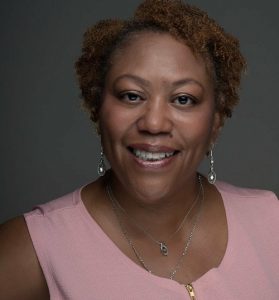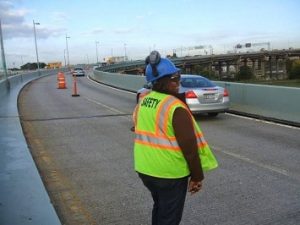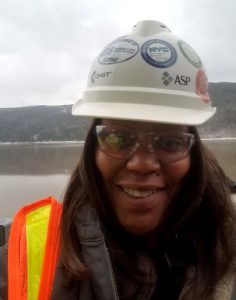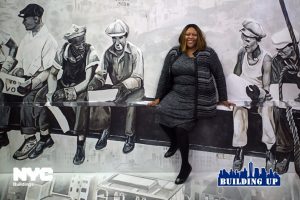For our EHS Leadership Week, Faces of EHS is profiling Crystal Turner-Moffatt, the president, principal consultant, and CEO of the safety firm CDT EHS Consulting LLC. Learn more about Crystal’s barrier-breaking journey as a safety professional and entrepreneur; her deep passion for environment, health, and safety (EHS); her thoughts on the importance of leadership, mentors, and sponsors; and the compliance and cultural issues she engages with every day as the “Safety Diva.”
 What led you to pursue a career in the EHS field, and what are you up to now?
What led you to pursue a career in the EHS field, and what are you up to now?
I have always had an interest in the sciences, from my first look at the microcosm of pond water in junior high to frog dissections in high school. I had designs on medical school at an early age and took part in programs such as Columbia/Barnard’s Pre-Medical Education Program while in high school, and upon graduation, I went on to study Psychology and Basic Sciences at Wesleyan University. From my undergraduate work learning to perform stereotaxic neurosurgery and microsurgery on animals to my neuroscience research at Tulane University, I was amazed and intrigued by the possibilities a career in the sciences would offer. I embarked on a research career and, over a 12-year period, landed research jobs in the neurosciences at research institutions such as Mt. Sinai Medical Center, Rutgers University, and Columbia Presbyterian Hospital. I discovered an interest in pharmacology while taking graduate courses in neuroscience and enrolled in a post-baccalaureate certificate program in toxicology. This experience was immeasurable, as it introduced me to the Society of Toxicology (SOT), where I learned that I could use my multifaceted talents, interests, and scientific skills and focus them in one field of study.
My educational pursuits continued and eventually led me to the Hunter College School of Health Sciences MS program in the Department of Environmental and Occupational Health Sciences (EOHS). While at Hunter studying environmental toxicology, I discovered that many of the toxicants and neurotoxicants that I was interested in had environmental links, causes, and etiologies. I began to study environmental and occupational health and industrial hygiene and continued my research, turning it into a master’s-level thesis. After the passing of my cousin and aunt, I took time off to help my mom raise my five cousins (who are now my adopted and foster children), and after returning in June 2002, the EOHS faculty thought that, given the special circumstances under which I took leave, the work I had completed, and the effort I put forth, I warranted graduation status.
I chose to make a professional career change from research after graduation and began to work in the fields of industrial hygiene and environmental and occupational health and safety. I went on to work in an EHS capacity in the pharmaceutical industry and for private industry, all while consulting independently for my own company and for companies such as Omega Environmental, Inc. I have also worked for regulatory agencies such as the New York City Department of Environmental Protection (DEP) and New York City Department of Health (DOH) and academic institutions such as SUNY Stony Brook.
In addition to all of my consulting work, additional employment, and my PhD candidacy, I also work in the community to draw attention to health disparities and environmental justice, and I started a health ministry in my spiritual community, as well. Health is important to me, and so is giving back!
So, long story short, I have education, experience, and expertise in research, the EHS profession, and the sciences for over 25 years, with 20+ years specifically in the safety profession. With my style of safety, I have branded myself the “Safety Diva” to stand out among the male-dominated (especially in construction) safety field. I have a unique approach as a problem-solver for my clients, not just as a safety “policeman” who points out deficiencies but also as a coach who is professional and ethical. I have been hired for difficult oversight jobs that require constant reporting to regulatory agencies, but all of the diligent and honest effort is more than worth it—we cannot be compromised and look the other way with regard to unsafe acts in the workplace.
Wow, your experience and education in the EHS field are extensive! What is the biggest EHS compliance challenge you have encountered over the years, and how have you helped your clients manage it?
The biggest EHS challenge is dealing with regulatory agencies and their laws and requirements, including the Occupational Safety and Health Administration (OSHA); the Environmental Protection Agency (EPA); the New York City DEP and Department of Buildings; the Port Authority of New York and New Jersey; the Metropolitan Transportation Authority (MTA); the U.S. Army Corp of Engineers—the list goes on! While many companies have corporate safety plans, from site-specific plans to emergency plans, fall protection plans to confined space plans, and job hazard analyses (JHAs), they often fail to implement or utilize them properly. This affects compliance in a profound way—in fact, it’s doomed from the start, and the plans are ineffective at mitigating risk. Naturally, this has an impact on safety, production, and measures such as Days Away, Restricted, or Transferred (DART) rates; emergency medical records (EMRs), total case incident rate (TCIR); lost time; near misses—all sorts of leading and lagging indicators.
 At CDT EHS Consulting, we assist small and medium companies and contractors with the implementation of their core plans, which leads to increased compliance, better core safety values, and a reduction of risk. Our motto is “Environmental Health and Safety is Our Passion; Serving You Ethically and Professionally, We Provide a Bridge to Safety Success.” Basically, we use our expertise to make our clients’ tasks easier. This saves them money by reducing OSHA or other agency violations and fines, not to mention insurance claims and lost time due to injury. In addition, being safety-conscious and improving their safety culture improves companies’ reputation and status in the industry, giving them more opportunities to thrive.
At CDT EHS Consulting, we assist small and medium companies and contractors with the implementation of their core plans, which leads to increased compliance, better core safety values, and a reduction of risk. Our motto is “Environmental Health and Safety is Our Passion; Serving You Ethically and Professionally, We Provide a Bridge to Safety Success.” Basically, we use our expertise to make our clients’ tasks easier. This saves them money by reducing OSHA or other agency violations and fines, not to mention insurance claims and lost time due to injury. In addition, being safety-conscious and improving their safety culture improves companies’ reputation and status in the industry, giving them more opportunities to thrive.
Are there any EHS challenges unique to the work you do that could prove instructive to other EHS professionals?
Safety managers frequently feel they are perceived as cops rather than coaches or mentors. I prefer to be a safety coach. Nick Goes, the chief of operations and general manager at Infinite Energy Construction (IEC) offers some strong insight about this particular challenge in a post on IEC’s blog. He notes that the issue is a question of balance. A safety professional’s strength arises from having a firm grasp of:
- Industry acceptability;
- Unique company hazards, strengths, and weaknesses;
- Challenges related to safety and health;
- The safety culture of the company or environment; and
- How to maintain an effective and efficient safety and health program.
You must also know their audience:
- Maintain proper communication at all levels.
- Utilize effective training methods, including safety briefings, toolbox talks, committee meetings, etc.
- Effective communication between the safety professional and workers should be central in the day-to-day functioning on the jobsite.
- Be an educator and mentor, rather than a taskmaster.
There are tasks on every jobsite that a safety professional might not have the training to carry out themselves. It falls to the safety professional to:
- Analyze a given task, and then walk the employee through a safe process to complete the task.
- Communicate with the employee at their level and do not talk down to them. Don’t be afraid to take your time and/or change up your methods to convey the level of seriousness.
- Get buy-in from everyone on site.
- Make sure all groups are properly informed of safety-related plans and procedures to encourage participation at all levels.
- Make sure everyone understands how safety hazards correlate to specific consequences and the potential negative outcomes for workers.
Get compliance without fear. To do that, employees need to be comfortable coming to you with potential issues. Have an open-door policy, avoid micromanaging, and trust workers to perform their tasks. Goes suggests that “safety professionals should offer guidance and suggestions about safe work practices when and where appropriate.” Be firm when the situation calls for it, but remain polite and always exhibit patience and professionalism.
Safety professionals are the cornerstones of safety and should have a seat at the table. Again, Goes notes that “the safety professional does not have an easy job, but the most successful companies have learned to maintain that essential balance on the jobsite, allowing them to uphold a high standard of safety while also understanding the dynamics of each crew, location, and project.”
It helps to PACE yourself:
Passion: As a safety professional you must embrace your role.
Accountability: For an effective safety culture, management and workers must be a team. All are responsible and must have zero tolerance for unsafe workplace acts.
Connect: Compliance through communication and mentoring is far better than compliance through fear.
Engage: Get the team on the bus with you. Ask yourself, how are you going to motivate team members? How are you going to serve? Are you going to motivate behavior positively or negatively?
Being informed by knowing your audience (workers, management, trades, etc.), the safety culture and company environment, organizational strengths and weaknesses, and how the health and safety plan will allow using a situational safety leadership approach will help maximize profitability and get safety a seat at the table.
 Was it a difficult choice to start your own EHS consultancy?
Was it a difficult choice to start your own EHS consultancy?
Raised in Harlem, New York, I have broken down barriers in the construction industry as a safety professional and business owner. I am proud to be an African-American woman in a largely white, male-dominated industry. I have seen many obstacles firsthand, and I’ve overcome them with a mix of tenacity, personality, and passion for safety. It is also in my DNA. I hail from a long line of entrepreneurs. My parents and grandparents, for example, all had their own businesses.
To me, EHS is a higher calling, so, while the choice was challenging, in the end, it was not difficult to make. I still struggle with being a 100% full-time entrepreneur, although it has been 15 years since I started the company. I still work for others during lean times. I started CDT EHS Consulting LLC because, at the time, there was a lack of opportunities at my level, and I wanted to be my own boss and serve my clients. I built my Minority- and Women-Owned Business Enterprise (MWBE)-certified safety firm to bring my skills, knowledge, and expertise, as well as the experience of those safety professionals I affiliate with, to those companies and institutions in need. Occupational health and safety is a “passion,” and being a safety professional is a calling and purpose that I practice professionally and ethically. I have a mission and commitment to serving clients and their employees professionally and ethically. Throughout my work history, I have maintained an excellent performance record and rapport with consultants, management, site safety personnel, and employees, including unions. I have earned a reputation for dedication, teamwork, and a trustworthy work ethic. I am proud that CDT EHS Consulting LLC provides my clients with a “Bridge to Safety Success.”
Through CDT EHS Consulting LLC, I bring my clients over 20 years of experience in multifaceted environments and a record of success overseeing multimillion-dollar construction, infrastructure, and EHS projects, and I have experience managing crews and subcontractors of 150 or more during bridge improvements, lead/asbestos/polychlorinated biphenyl (PCB) abatements, clean water and wastewater plant upgrades, HAZWOPER initiatives, and a variety of other construction/demolition projects. My knowledge is backed by strong credentials and a proven history of safe, efficient, and high-quality project safety oversight. And I continue to expand my knowledge base, completing a Master of Science in the EOHS program at Hunter College CUNY and now as a doctoral candidate at Capitol Technology University’s Occupational Health and Safety program.
What advice would you give other safety professionals looking to start their own business?
The advice I would give is to get certifications and education to gain credibility. Learn the vernacular in your field, and take away all you can from every experience. Get not only a mentor but also a sponsor to advocate for you and help you navigate the waters. Brand yourself. For example, my motto is “EH&S is my passion,” and my handle is “The Safety Diva.” Network and get involved in national organizations like the American Society of Safety Professionals (ASSP) and the American Industrial Hygiene Association (AIHA). Start your own groups, and continue to build relationships. Most importantly, make sure EHS is not a job but a vocation and passion.
What do you like the most about your career in EHS?
I love being with people. EHS has exposed me to many great people, everyone from individual trade workers to CEOs. For me, safety has been a professional and spiritual calling for 25 years. When I sense danger, the hairs on the back of my neck stand up. While on construction sites, I am always doing a visual assessment to spot people without their hard hat, safety glasses, or hearing protection. A mentor of mine used to drum into my head the importance of using a health and safety plan as an EHS bible—sage advice that I took to heart.
When I started managing contractors, I became like a den mother and gained their trust between my deep concern for their well-being and use of humor. With so many men in hard hats on the jobsite—and plenty of testosterone flowing—I would always kid around about being their safety wife or safety girlfriend and learned to be thick-skinned about all the teasing, cursing, and inappropriate comments. Now, in the #MeToo era, there is a fine line between joking and offending.
Still, there is an interesting synergy between men and women that’s different from when people from the same gender work together, particularly in construction. Women lead from a different perspective, which I think can create a more relaxed, creative, and collaborative environment with family-oriented teambuilding. While men tend to be more analytical, women are more verbal. But you also want the workforce to feel comfortable sharing their problems and frustrations. In the end, we all know that good communication and trust drive success.
Women in EHS constantly need more education and a comprehensive skill set to be credible and prove their worth. I have four sets of certification letters after my name for this very reason. Women also need to learn the vernacular of general contractors, carpenters, and masons, as well as electricians and heating, ventilation, and air conditioning (HVAC) professionals. In addition, it is critical to have field skills. There is no way you can do safety from a trailer or an office. You must get out, boots to the ground, and interact with workers. That is why I love EHS! I get to interact with people as a work family and use every bit of knowledge from every area of my life in totality to be a safety professional.
What is the most difficult or frustrating part of your job?
It comes down to safety culture. Safety cultures, according to OSHA (2018), “… consist of shared beliefs, practices, and attitudes that exist at an establishment. Culture is the atmosphere created by those beliefs, attitudes, etc., which shape our behavior.” A safety culture creates an environment of holistic commitment to safe practices, procedures, and equipment. In a positive safety culture, everyone accepts personal responsibility for ensuring the health and safety of themselves and others. Supervisors and managers see health and safety practices and procedures as a requirement, and the things they do demonstrate their commitment to health and safety. A safe culture is a happy, high-performance culture, and long-term productiveness is related to sustainable, safe processes. Working together toward the same goals and monitoring progress are key to maintaining a culture of safety.
It can be frustrating to work with a company that has a negative or no safety culture, especially when the safety team knows better but there is no buy-in from management. Also, working with a small company that just does not know any better can be challenging. There is a “get it done” mentality no matter the cost in both cases. That could be a worker incident, accident, or death. Not wanting to bring safety to the forefront or even to the table can be detrimental. Safety professionals should be allowed to contribute to the company by assisting in developing proactive solutions instead of just reacting to problems. To employ or utilize a safety consultant for a few hundred dollars an hour, or to cover an average salary for a safety professional of about $80,000–$100,000, is far less than the cost of a claim, which could be in the millions. That can halt any job or close a company. Getting companies to recognize their pain points and the need to invest in safety is very frustrating.
 What advice do you have for people just entering or transitioning into an EHS career?
What advice do you have for people just entering or transitioning into an EHS career?
I love to research, teach, and give back to the community, with the aim of inspiring young people, and especially women of color, to enter the science, technology, engineering, and mathematics (STEM) fields. EHS is not exactly an employment opportunity that students learn about in school, and it is hard for young people to imagine themselves working as a safety manager or supervisor. The first real step along this career path would be to enroll in STEM courses and, along the way, find ways to benefit from others’ mentorship and experience. Once the die is cast, mentoring is a tremendous launching pad for newcomers to build confidence, model themselves after an accomplished professional who inspires them, receive guidance on how they should structure their résumé, earn valuable certifications, and build a highly rewarding career.
When you first begin your career, it is important to enlist a few great mentors. I’ve had some great ones, including former National Institute of Environmental Health Sciences (NIEHS) director Kenneth Olden, PhD, a longtime member of SOT whose ideas and efforts were instrumental in the founding of the African Society of Toxicologists (ASTS). Olden told me of the possibilities for employment in the field after graduation and was very encouraging to me as a woman and minority toxicologist to press on. In the years since, I have been a host mentor for the Committee on Diversity Initiatives (CDI) for SOT’s undergraduate student education programs, and I feel that it is wonderful to have come full circle. Many SOT members encouraged me, and I make a point to encourage other toxicologists of color every chance I can.
So, as your career advances toward midlevel opportunities and beyond, you should enlist a diverse slate of mentors, and then you must seek out an elite category of advocate: a sponsor.
A mentor advises the mentee; sponsors advocate for their protégés. A mentor can be anyone in a position of experience, while a sponsor is a senior-level executive. Sponsors drive their protégés’ career vision. Mentors are great—they provide behind-the-scenes advice and support. They help you learn. But sponsors are key to your career advancement. They are on the front lines and will tell others that you are the person for the job.
| Crystal D. Turner-Moffatt, CSP, SMS, ASP, CHST, CSFSM, is CEO of CDT EHS Consulting LLC and is also employed part time by the Center for Environmental Health and Toxicology (CTEH) LLC as a health and safety supervisor overseeing COVID-19 compliance on movie and television productions. Her numerous previous employers include Pyramid Safety and Health Solutions, SA Engineering LLC as a CSP Senior Safety Engineer for the MTA, and Waters Construction as the Director of Safety 2019–2020. Turner-Moffatt has performed safety oversight and loss control on projects for the New York City DEP, Liberty Mutual Insurance, the World Trade Center, the U.S. Army Corps of Engineers, and the Throgs Neck Bridge, among many, many others. She is also a professional member of the ASSP and is a past president and board member of the Hudson River Valley (Platinum) chapter and currently serves as the Blacks in Safety Excellence (BISE) National Administrator.
As the CEO, President, and Principal Consultant of CDT EHS Consulting LLC, she performs safety inspections and implements new safety policies and procedures that elevate corporate safety culture for her clients. Learn more about Turner-Moffatt’s professional career at https://www.cdtehsconsultingllc.com/about and https://safetydivasacademy.wixsite.com/safetydiva. |

Would you like to be profiled in a future Faces of EHS and share your experiences, challenges, etc.? Or, do you know anyone else in EHS you think has an interesting story to tell? Write us at ehsposts@SimplifyCompliance.com and include your name and contact information; be sure to put “Faces of EHS” in the subject line.

